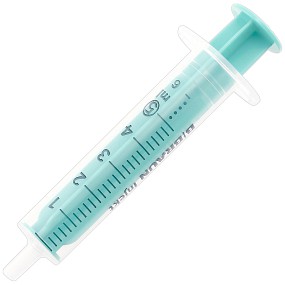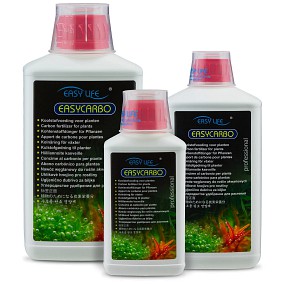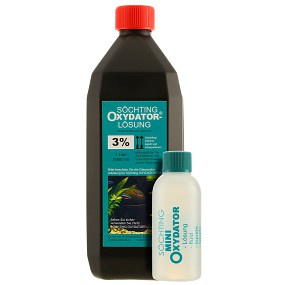In this article we'd like to show you a way to control specific algae in a targeted way. This method does not treat the entire tank with an algicide but deals with minor local algae populations.

For this purpose you'll need a standard disposable syringe that can hold 5 ml of liquid, and Easy Carbo from Easylife or hydrogen peroxide.
How to proceed
With this method you can treat local minor algae populations with an algicide in a very targeted way. The remedy is applied to the algae in the aquarium under water, we call this "fogging", and the method is correspondingly called the "fogging method". For doing so, draw the amount of liquid necessary for treating your tank volume up into the syringe. If the amount is larger than the syringe volume, you'll need to repeat this process in the course of the treatment. For the remedy to take effect, the current in the aquarium needs to be as weak as possible. Draw the plug on filters and pumps before you start. Then you spray the liquid under water directly on the areas where the algae grow. Please make absolutely sure you do not hit any plants or animals with the liquid as they might suffer damage! Especially mosses like Riccardia sp. (coral moss) or Riccia fluitans (liverwort) are very sensitive, and direct contact with algicides can have very negative effects. After a few minutes during which the remedy takes effect the filter and/or pumps are plugged in again.
Repeat this treatment once a day for three to four days in a row. This is sufficient in the most cases and will damage the algae significantly. Otherwise, just repeat the treatment. Ideally you'll make a pause for two days to give the ecological system in your tank some time to recover.
Types of algae
By fogging, most of the algae types in the aquarium (red algae, green algae, blue-green algae) can be controlled locally. We especially recommend this measure for algae that are not eaten well by algivores and that are hard to remove manually, like for example black beard or brush algae, staghorn algae or Cladophora sp. . Red algae like staghorn or brush algae will turn white or light pink a few days into treatment, which is a clear sign for them dying off. As soon as you notice such discoloration you can stop the treatment. Green algae tend to react much more slowly, and significant damage may only be visible after as long as a week. As a rule, algae-eaters like Amano shrimp will happily devour the algae bit by bit once they have died off.
Easy Carbo
According to the manufacturer's instructions, a dosage of 1 to 2 ml of Easy Carbo is added per 50 liters of aquarium volume. Please note: The higher the concentration of Easy Carbo in the aquarium water, the stronger the oxygen depletion will be. For this reason you need to make sure that the tank is well-aerated. As additional safeguard, you can increase the movement of the water surface by adding an air stone or by placing the filter outlet higher above the water surface.

First you need to calculate the amount of algicide that you need. To get the standard dosage (1 ml of Easy Carbo per 50 liters of aquarium volume) you divide the gross volume of your aquarium in liters by 50. This will give you the necessary amount of Easy Carbo in milliliters. If you want to apply double the concentration (2 ml of Easy Carbo per 50 liters), you just multiply the result by 2.
An example: The aquarium in question has a volume of 120 liters. For the standard dosage, your calculation is as follows:: 120/50=2.4 ml of Easy Carbo. For the double dosage your calculation would be: 120/50*2=4.8 ml.
Easy Carbo is especially effective against red algae, with green algae it is a little less potent.
Hydrogen peroxide
We recommend using the 3% solution for the Söchting Oxydator. Please make sure the hydrogen peroxide solution you use does not exceed a hydrogen peroxide (H2O2) content of 3 per cent. Other percentages will lead to errors in calculations and may result in an overdose that can do severe damage. Hydrogen peroxide is especially effective against green algae and blue-green algae (cyanobacteria). It is heavier than water and sinks to the ground, which is useful if you're dealing with algae near the ground and somewhat of a hindrance if the algae are higher up in the tank.

First you need to calculate the amount of 3% solution you'll need for treating your aquarium again. For doing so, divide the aquarium volume by 30 and multiply the result by 5. The result this operation gives you is the amount of solution in milliliters you'll need for a single treatment. Again, we're using a tank with a volume 120 liters as an example: 120/30*5=20 ml. The factor 5 in this formula is the concentration of hydrogen peroxide in the aquarium water in ppm, or mg/l, by the way.
Immediately after the addition of hydrogen peroxide, in the treated areas numerous tiny air bubbles will form. They consist of pure oxygen and are not harmful.
Combination
If you have both remedies at hand, you can do a combined treatment with hydrogen peroxide and Easy Carbo. Of course, the two solutions must not be mixed; please add them at the same day, but with a little time between treatments. The simultaneous use of H2O2 and Easy Carbo has the advantage that the oxygen depletion that may be caused by Easy Carbo is more than leveled out by the oxygen produced by the hydrogen peroxide. The combined use of both algicides increases their effectiveness considerably.
Safety information and disclaimer
Please read the safety instructions of each product before use. Avoid direct contact with skin, eyes and clothing, as well as direct contact with animals or aquatic plants. We recommend the use of protective gear (goggles, gloves). Use at your own risk! We do not assume any responsibility for damages that may result from this treatment.